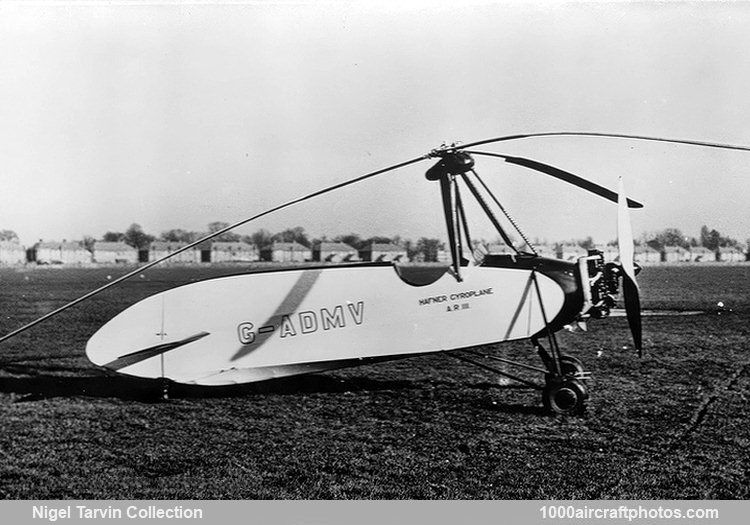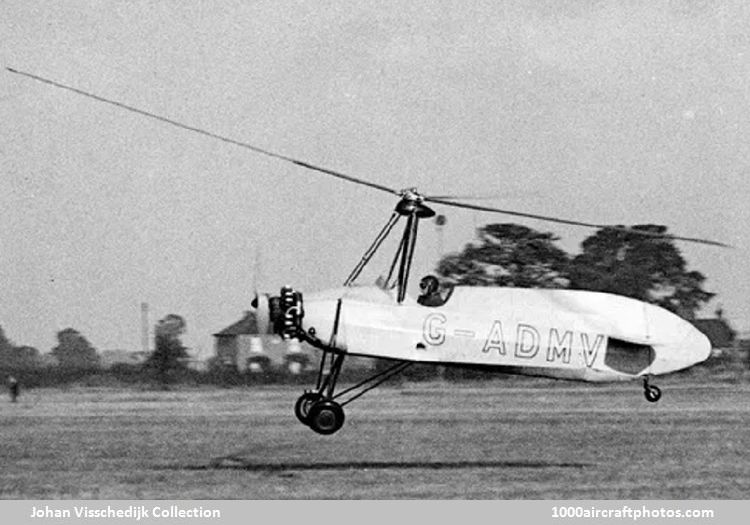Photograph from The Aeroplane, taken at London Air Park, Hanworth, England, February 6, 1937
04/21/2025. Remarks by
Johan Visschedijk: "Engineer Raoul Hafner of Vienna, Austria had built, in collaboration with Bruno Nagler, the small single-seat Hafner Nagler R.I and R.II Revoplane experimental helicopters in 1929 and 1931. Hafner's work in Vienna had been financed by Scottish cotton magnate Major Jack Coates. Coates had the R.II shipped to Heston Airport, near London, England in 1933 where it made tethered flights.
In 1933 Hafner got in contact with the Cierva Autogiro Co. Ltd. and the work of the Spanish gyroplane pioneer Juan de la Cierva. Subsequently Hafner learned to fly the Cierva C.19 and C.30 and gained an Aviators Certificate from the Royal Aero Club on September 14, 1933. From then on Hafner focused on the design of gyroplanes, formed the A.R.III Construction (Hafner Gyroplane) Co. at Feltham, near London in 1934, and started the design of the Hafner A.R.III Gyroplane, the A.R. was signifying 'Auto Rotation'.
The Gyroplane was built by A.R.III Construction in the Martin-Baker factory at Higher Denham, Buckinghamshire, and was registered to Thomas Vaughan Welsh of Heston as G-ADMV on July 26, 1935, shortly thereafter it was completed and transported to Heston.
A.R.III Gyroplane in original form, September 1935 (
Johan Visschedijk Collection)
Powered by a 84 hp Pobjoy Niagara III seven-cylinder air-cooled radial engine, it was first flown at Heston, with V.H. Baker at the controls, in September 1935. It was then experimented with and modified until Hafner was confident it could be demonstrated with confidence, the Gyroplane was again demonstrated to the press on February 6, 1937. The modified version was referred to as Hafner A.R.III Gyroplane Mk.II, although the 'Mk.II' was not added in the UK Civil Aviation Authority manual registration register, nor applied to the aircraft.
The Gyroplane made numerous demonstration flights in the United Kingdom, but had its first public demonstration on May 9, 1937, when Flying Officer A.E. Clouston flew it at the garden party of the Royal Aeronautical Society at the Great West Aerodrome (presently known as Heathrow). The Gyroplane was the first autogiro with articulated blades which had a combined cyclic-and-collective control system. Although this machine was not capable of hovering, it marks a milestone in helicopter technology.
During а conference held in Philadelphia, Hafner explained the difference between the Cierva system and his own as follows: "The fundamental difference between the two rotors lies in the fact that the hub of the Hafner rotor rotates about а rigid axle through which all the flying loads are carried direct to the fuselage, while the variation of incidence is achieved by separate control linkage which enables the rotor to be controlled with small efforts on the control column."
The hub embodied а "spider", the three claws of which were attached to the blade control levers. The "spider", since incorporated into all the Bristol helicopters, was fitted with а central axle running through the hollow interior of the rotor shaft and connected to the pilot's stick by а system of ball joints and levers, so that it could ensure differential pitch in the blades. This, together with the collective and cyclic pitch control the gyroplane possessed, enabled it to do everything which Cierva did by means of the tilting head in his designs. The Gyroplane could also land on the spot, thanks to its collective pitch control, through which the pilot could utilize all the rotor's kinetic energy. It had no fixed wing, but it did have а conventional rudder and its tailplane was designed to counteract torque.
The Gyroplane was tested at Farnborough by A.E. Clouston, later it was leased for research to the Royal Aircraft Establishment at Farnborough. It was scrapped during W.W.II and the registration was cancelled by the Secretary of State on December 1, 1946."
More details can be found in the National Advisory Committee for Aeronautics'
Aircraft Circular No. 205.

